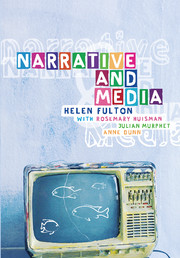Book contents
- Frontmatter
- Contents
- Figures and tables
- Contributors
- Acknowledgements
- 1 Introduction: the power of narrative
- Part 1 The basics of narrative theory
- 2 Narrative concepts
- 3 From structuralism to post-structuralism
- Part 2 Film as narrative and visual mode
- Part 3 Television: narratives and ideology
- Part 4 Radio and print journalism
- Part 5 Popular print culture
- Glossary
- Bibliography
- Index
3 - From structuralism to post-structuralism
Published online by Cambridge University Press: 05 June 2012
- Frontmatter
- Contents
- Figures and tables
- Contributors
- Acknowledgements
- 1 Introduction: the power of narrative
- Part 1 The basics of narrative theory
- 2 Narrative concepts
- 3 From structuralism to post-structuralism
- Part 2 Film as narrative and visual mode
- Part 3 Television: narratives and ideology
- Part 4 Radio and print journalism
- Part 5 Popular print culture
- Glossary
- Bibliography
- Index
Summary
Martin McQuillan, editor of The Narrative Reader, describes the usual history of narrative theory as a story:
Histories of narrative theory tend to follow a familiar pattern … The story goes: In the beginning there was Aristotle who theorised ‘plot’, then there came the novelists who theorised their own plots, then after some false starts (Propp, Benjamin, Bakhtin) narrative theory really took off with narratology (the structuralist-led ‘science of narrative’). However, like the dinosaurs, narratologists died out and were replaced by more mobile, covert forms of narrative theory within a ‘post-structuralist’ diaspora. Narrative theory now lives on, embedded in the work and tropes of post-structuralism.
(McQuillan 2000: xi)In this Darwinian account, McQuillan parodies the oversimplification of the ‘evolution’ of narrative theory. The linear storyline is too simple because it assumes a reductive Enlightenment myth of progress, where what comes after necessarily replaces and is better than what came before. (Conversely, by those critics who shudder at the word ‘post-structuralist’, or its stylistic companion, ‘postmodernist’, the same succession of theories can be interpreted as a story of decadence and decay.)
In this chapter I describe some of the major differences between theories. It is well to remember that people have different purposes in analysing narrative, and some theories better suit different purposes. This is particularly so in relation to the study of commercial media texts, as the discussions in the following chapters will illustrate.
- Type
- Chapter
- Information
- Narrative and Media , pp. 28 - 44Publisher: Cambridge University PressPrint publication year: 2005



